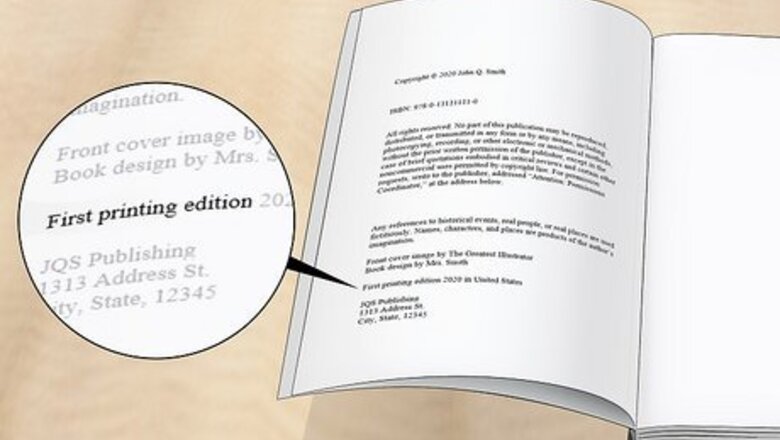
views
- Check if the words “First Edition” are printed anywhere on the copyright page at the front of the book.
- Look for print run numbers, like "1 2 3 4 5 6 7 8 9" or "9 8 7 6 5 4 3 2 1," on the copyright page. If there’s a 1 somewhere in the line, then you have a first edition.
- Compare the copyright date to the original publishing date of your book. If they’re the same, then it’s most likely a first edition.
Identifying a First-Edition Book
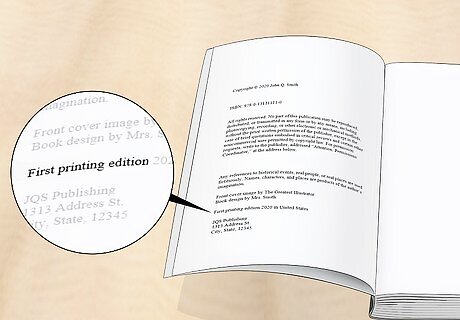
Look for the words “First Edition” printed on the copyright page. Open your book and locate the copyright information usually found on the back of the title page. Scan line by line to see if the words “First Edition” show up anywhere on the page, which means the copy of your book is the original version that was published. If you don’t see the words printed anywhere on the page, then you may have a later edition of the book. Many publishers label the first printings of a book in both hardcover and paperback as first editions. Hardcover copies are typically released before paperback versions, so they may be considered “true” first editions.
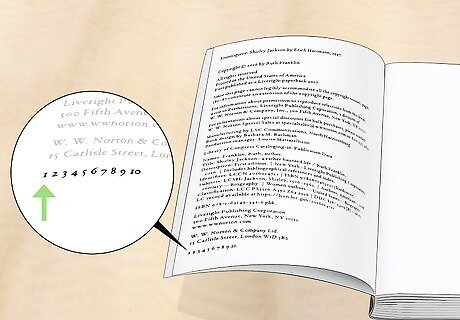
Check for “1” listed in the line of print run numbers. Look on the copyright page for a string of ascending or descending numbers where 10 is the highest and 1 is the lowest, such as “1 2 3 4 5 6 7 8 9 10” or “10 9 8 7 6 5 4 3 2 1.” When the lowest number on the line is a 1, that signifies you have a first-edition print run of your book. If you have a book that was reprinted, then the lowest number signifies the which edition you have. Sometimes, the print run numbers may not be in sequential order, like “2 4 6 8 10 9 7 5 3 1.” As long as 1 is still the lowest number on the line, then you still have a first edition. Instead of “10,” you may instead see “0” in the print run numbers. If you see a "1" and "0" in the print run numbers, the "1" is still the lowest number and marks that you have a first-edition copy. If the copyright page says “First Edition” and you still see a list of print run numbers, look at the lowest number to determine how many times the edition has been reprinted. If 1 is the lowest number, you have a first-edition copy from the very first printing.

Confirm that the copyright date matches the publication date. Check the title page to see if the publication date is listed at the bottom and find out how old the book is. Otherwise, the publication date may be listed on the copyright page next to the words “First Edition” or listed as the lowest 2-digit value in the print run numbers. Look for the copyright date near the top of the page following the © symbol. If the publishing date is the same as the copyright, then there’s a really good chance you have a first edition. Example: If the print run numbers look like “15 16 17 18 19 / 9 8 7 6 5 4 3 2 1,” then the “15” signifies the publishing year was 2015 and the book is part of the first print run. If the copyright date is also 2015, then you have a first edition. If the copyright page has print run numbers as well, check that the 1 is present in the number line. If you don’t see the number 1, then your book may be a later printing of the first-edition text.
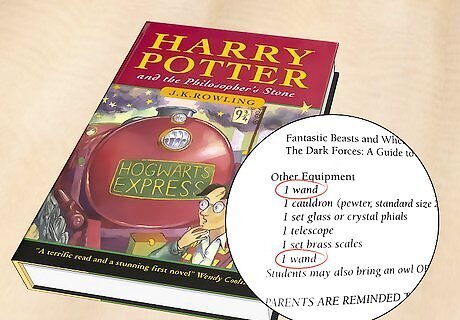
Search for typos and misprints edited out of future editions. Many publishers will fix typos or make changes to a book in between editions, so older copies may have more mistakes. Do a Google search for the title of your book followed by “first edition differences” to find out what edition you have based on the major differences in the text. Skim through the book’s pages to see if the errors are still there to know if your book is a first-edition copy. Example: If you have Harry Potter and the Philosopher’s Stone, check how many times the phrase “1 wand” is listed on page 53. If “1 wand” is written twice on the page, then you have a rare first edition, but the typo was corrected in reprints.
What is the difference between printings and editions?

Printings are reprints of the same text within the same edition. When a book is first published and printed, those original copies are the first edition and the first print run. If the publisher wants to produce more copies without changing the text, then they’ll do a second printing of the book. If the publisher prints the book after fixing typos, adding an introduction, or editing any of the text, then it’s considered the first printing of the second edition. First printings of first editions are usually the most valuable since they are the earliest available copies of a book.
Are first-edition books valuable?
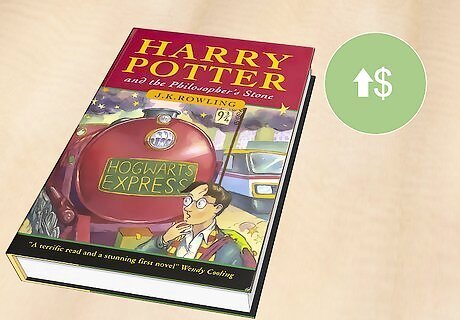
Your book may be valuable if it’s an important text or if it’s hard to find. Just because your book is a first edition doesn’t necessarily mean it’s worth money. If the book was part of a large print run, then it won’t be as valuable as books that only had a few hundred printed. If a book gains a lot of popularity since its original release or was written by a renowned author, that may also boost the value of your first edition. Try searching online for the title followed by "first edition value" to find out how much your book is worth. Book collectors will also look at the book’s condition to determine if it’s valuable. If there isn’t any damage or wear on the book, then it may be more valuable than a heavily-used copy. Any book that was published before 1900 is potentially valuable since it’s considered an antique.



















Comments
0 comment